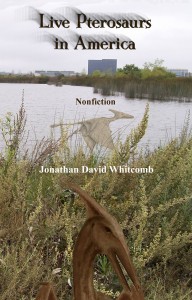Do most eyewitnesses of living pterosaurs (or apparent living pterosaurs) just misidentify birds? More to the point of what I’m looking for, have many of those eyewitnesses been in a frame of mind to conclude “pterodactyl” when they are startled by a bird flying overhead? Does some kind of predisposition cause them to make that kind of misidentification?
I take myself as the first example, although I have not yet seen what has been seen by the many eyewitnesses I have interviewed over the past eight years: a live pterosaur. Heron, crane, egret—each could be mistaken for you know what. Over the past eight years, most of my associates in living-pterosaur investigations have had at least one sighting of what could have been a living pterosaur. It’s beginning to look like I am rarer than those flying creatures, since I am an active investigator who has never seen one of those creatures (granted, I have not been on as many expeditions as some of my associates). If anybody has a predisposition to see a bird and think it is a pterosaur, it could very well be me, for my dreams, at times, include a sighting the one portrayed as extinct. But in waking life, when I happen to see a heron or crane or egret, I watch carefully and soon conclude “bird.”
When they first notice something flying, many eyewitnesses assume it is a bird; only after looking at it for awhile do they notice things like a long tail with a structure at tail-end and a head crest and a featherless appearance (a few eyewitnesses even see teeth: rather un-bird-like). Let’s examine some examples.
Scott Norman (cryptozoologist)
Scott was sure that his friends had seen a bird, for he had looked carefully at the video that had taken of it; still, at a secret location, in the summer of 2007, he agreed to take a turn watching the sky. Later that night, when he had his own sighting, he pondered carefully what he had observed, waiting hours before committing himself to the interpretation “pterosaur.” Other cryptozoologists who had known Scott well, had learned to trust his objectiveness and were impressed with his encounter.
Kentucky Sighting (from Live Pterosaurs in America – now in its third edition, available on Amazon and from other book sellers)
I live at . . . Bowling Green, Kentucky. Today I opened my back door around 4:30 p.m. . . . and I noticed a large bird in the sky flying above me. I thought it seemed strange because I [saw] a tail with a spade-like end; also the wingspan was a lot larger than any bird I have ever seen around here. The wings did not flutter rapidly: Each wing stroke was steady and powerful.
Notice in the above account the initial thought of the eyewitness. He assumed what was flying overhead was a bird. Only after watching it for awhile did he conclude it was not a bird. He also said:
I am confident [that] what I [saw] was absolutely not a standard bird with feathers; there were no feathers that I could see.
Wisconsin Sighting (from the same cryptozoology book: LPA-2)
I had just brought out the tractor to pick up the bags of cucumbers when I noticed a strange looking bird in the sky. Unfortunately I was the only one out there at the time. The thing that caught my eye was that it looked like something straight out of the dinosaurs era.
Pterosaur Sighting in Michigan
I was driving from Muskegon, Michigan, to Fremont, at 8 p.m., with my family, on 8-18-07 . . . It was still light out but it was raining gently and cloudy. . . . just leaving the city before Highway M-120, when in the sky just above and in front of our car, I saw a large dark colored bird flying from the west . . .
At first glance, it didn’t look extraordinary; it looked like a [heron] or crane bird. After looking at it more thoroughly, I saw that it had a spike out the back of the head. Then I saw a long tail with a diamond shape at its end. . . . The animal was seen very clearly and the tail and diamond shaped end was also unmistakably clear.
In the two sightings above (Wisconsin and Michigan), we again see that the eyewitnesses first assumed “bird.” The man in Michigan even thought of two specific species of bird: heron and crane. But diamond at the end of a long tail and the pointed crest at the back of the head combined to eliminate those birds.
Woodward, Oklahoma Sighting (again quoting from the cryptozoology book)
I was walking to the small river where I usually caught carp fish. . . . a large animal took off into the air. At first I thought it was an eagle. Then I noticed it was a dinosaur. I went to my knees so that it would not see me. I was afraid it would eat me. I stared at the back part of the head because it was exactly like the ones depicted in books.
The point is simple. Many of the eyewitnesses are not startled by a bird and thus frightened to the point of thinking “pterodactyl.” Many sightings allow time for the observer to see that it is not a bird, as originally assumed, but something else, something very strange . . . prehistoric-looking.



